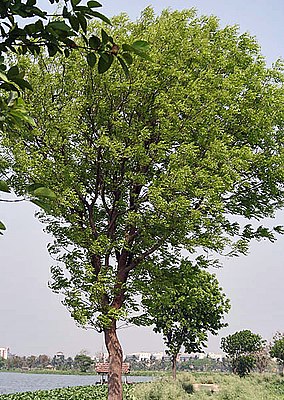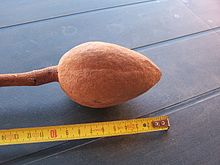Swietenia mahogany
| Swietenia mahogany | ||||||||||||
|---|---|---|---|---|---|---|---|---|---|---|---|---|

Swietenia mahogany |
||||||||||||
| Systematics | ||||||||||||
|
||||||||||||
| Scientific name | ||||||||||||
| Swietenia mahogany | ||||||||||||
| ( L. ) Jacq. |
Swietenia mahogany , also known as West Indian mahogany , is a species of plant withinthe mahogany family (Meliaceae). It occurs in southern Florida in the USA , on the Caribbean islands including the Bahamas , Cuba , Jamaica and Hispaniola . For example, it is used as an avenue tree in South Florida.
Swietenia mahagoni is one of the endangered tree species of the genus Swietenia (along with Swietenia macrophylla and Swietenia humilis ), which have been protected by CITES Appendix II since December 2002 . In the Red List of Threatened Species of IUCN in 1998 Swietenia mahogany "high risk" as "endangered" = classified, the current degree of risk is not known.
Description and ecology
Appearance, bark and leaf
West Indian mahogany grows as a semi-evergreen to evergreen tree and can reach heights of up to 25 m or even higher. On average, an adult tree is 12 to 15 m tall and has a symmetrical, round crown with a moderate leaf density. Sometimes smaller buttress roots are formed. It is resistant to breakage . Sagging branches and green to brown twigs are typical of this species. The young specimens have a smooth, greyish bark that becomes darker or reddish-brown and fluted with age or becomes scaly.
The alternately arranged, paired, pinnate and stalked leaves are around 12 to 30 cm long in adult specimens. The leathery, short-stalked pinnate leaves are ovate to lanceolate, 5 to 10 cm long and 2 to 5 cm wide and pointed to pointed and mostly with entire margins. The lamina is often uneven, the top is glossy, the underside matt green.
Inflorescence, flower, fruit and seeds
The West Indian mahogany has stalked, small greenish, five-fold flowers with a double perianth, which are arranged in up to 15 centimeters long panicle inflorescences . There are female and male flowers, so the tree is monoecious . In the female flowers a five-chambered, upper ovary with a short style and a disc-shaped stigma is formed. In the female flowers there are tubular, overgrown staminodes (sterile stamens) with (pointed) lobes. In the male flowers there is a reduced and sterile pistillode (sterile pistil) and 8 to 10 stamens that have grown together to form a tube with (pointed) lobes, inside and on the upper edge are the anthers. At the base of the flowers, around the ovary, there is a reddish nectar disc, although this is much more pronounced in the male flowers.
The brown, woody and five-lobed capsule fruits are egg-shaped and about 7.5 to 15 cm long, they hang on narrow stems in winter. When ripe, they usually burst at the bottom, but also at the top, and the 35 to 45, flat, winged and red-brown, 5 to 7 centimeters large seeds, which hang with the wing on a thick, pentagonal central column, are blown by the wind spread out. The pods are dry or hard.
Wood properties
Wood species of the genus Swietenia have clearly recognizable growth zone boundaries . The sapwood is yellowish-white, usually clearly separated from the rosy to red-brown heartwood , which has a fine or very fine structure. The wood fibers are straight or slightly coupled. With the appropriate incidence of light, a clear gold sheen appears on the surface.
The smell of the wood is not pronounced or absent. Their vessels (pores) are dispersed, grouped and have no specific arrangement; usually in short radial rows, from two to three cells. The tangential pore diameter is medium or large ([90-160-255] µm). They have a small number of pores per mm 2 (2–18). Thylles are not present. Axial parenchyma (storage tissue) are banded. The parenchyma bands are exclusively marginal (or seemingly marginal) and narrow.
Technical wood data
| Parameter | value | unit |
|---|---|---|
| Bulk density | 0.48-0.54 | g / cm 3 |
| Compressive strength | 51-60 | N / mm 2 |
| modulus of elasticity | 8800-11300 | N / mm 2 |
| Flexural strength | 90-104 | N / mm 2 |
| tensile strenght | 100-110 | N / mm 2 |
| Shear strength | 7-8 | N / mm 2 |
Location requirements
West Indian mahogany can grow in full sun, partially in the sun or in partial shade. It has a high tolerance to drought and salt aerosol . Regular fertilization and a well-drained soil can lead to rapid tree growth. West Indian mahogany can live in alkaline, occasionally moist, or well-drained soil.
use
West Indian mahogany is suitable for road planting. The wood plays an important role in export in the form of square timber , veneer wood and plywood panels. It is used both outdoors and indoors and is particularly suitable for outdoor construction without ground contact (marine building regulations). Other possible uses are e.g. B. in the production of decorative veneers , fittings , carpentry and musical instruments . From 1514 the Spaniards used the wood to build their ships, the Spanish Armada was built from this wood.
Individual evidence
- ↑ a b c d e Edward F. Gilman and Dennis G. Watson (1993): Swietenia mahagoni: Mahogany, one of a series of the Environmental Horticulture, ENH-766 .
- ↑ a b c d HG Richter, K. Gembruch, G. Koch: CITESwoodID: descriptions, illustrations, identification and retrieval of information, Swietenia spp. (Real Mahogany, True Mahogany) - CITES II .
- ↑ Swietenia mahagoni in the IUCN Red List of Threatened Species 2014.3. Listed by: Americas Regional Workshop (Conservation & Sustainable Management of Trees, Costa Rica, November 1996), 1998. Retrieved January 14, 2015.
- ↑ A. Basu, A. Ghosh, S. Palet et al .: Pollination of the Mahagony Trees (Swietenia mahagoni) by an Ovipositing Thysanopteran Iinsect (Priesneriola). In: Bionotes. 15 (3), 2013, pp. 88-89.
- ↑ M. Chichignoud, International Tropical Timber Organization, Center technique forestier tropical (France) (1990): Tropical timber ATLAS of Latin America . International Tropical Timber Organization, S. 138, 139 .
- ^ Karl spokesman, Martin Bauert: Plants and mushrooms in the Masola rain forest. ( Memento from July 19, 2018 in the Internet Archive ) (PDF; 12.5 MB), at Zurich ZOO, accessed on July 18, 2018.
Web links
- Swietenia mahagoni from Prota, accessed on July 19, 2018.
- Swietenia mahagoni from Useful Tropical Plants, accessed July 18, 2018.
- Swietenia mahagoni (PDF), at University of Copenhagen, accessed on July 19, 2018.
- Swietenia mahogany in the Flora of Cina, Vol. 11.




